Literature Review: Analyzing the Impact of IT on Accounting Processes
VerifiedAdded on 2021/05/31
|7
|1946
|252
Literature Review
AI Summary
This literature review explores the transformative impact of Information Technology (IT) on accounting practices. It examines how IT enhances speed, accuracy, and efficiency in financial computations and reporting, as highlighted by Lim (2013) and Banker, Chang, & Kao (2002). The review emphasizes the positive relationship between IT implementation and increased productivity, as well as the reduction of errors in financial data management. It also discusses the role of Accounting Information Systems (AIS) in improving performance and productivity, particularly in SMEs, as evidenced by Urquía, Pérez & Muñoz (2011). While acknowledging some mixed findings, the review underscores IT's contribution to improved accounting management and the elimination of traditional overheads, as noted by Amiri, & Amiri (2014). Furthermore, it highlights the legal requirements and regulatory demands for IT applications in accounting, such as the use of CAATs in Uruguay, as discussed by Gambetta, García-Benau, & Zorio-Grima (2016). The literature concludes that IT is essential for business survival, expansion, and growth, due to its positive impact on performance, productivity, and management.
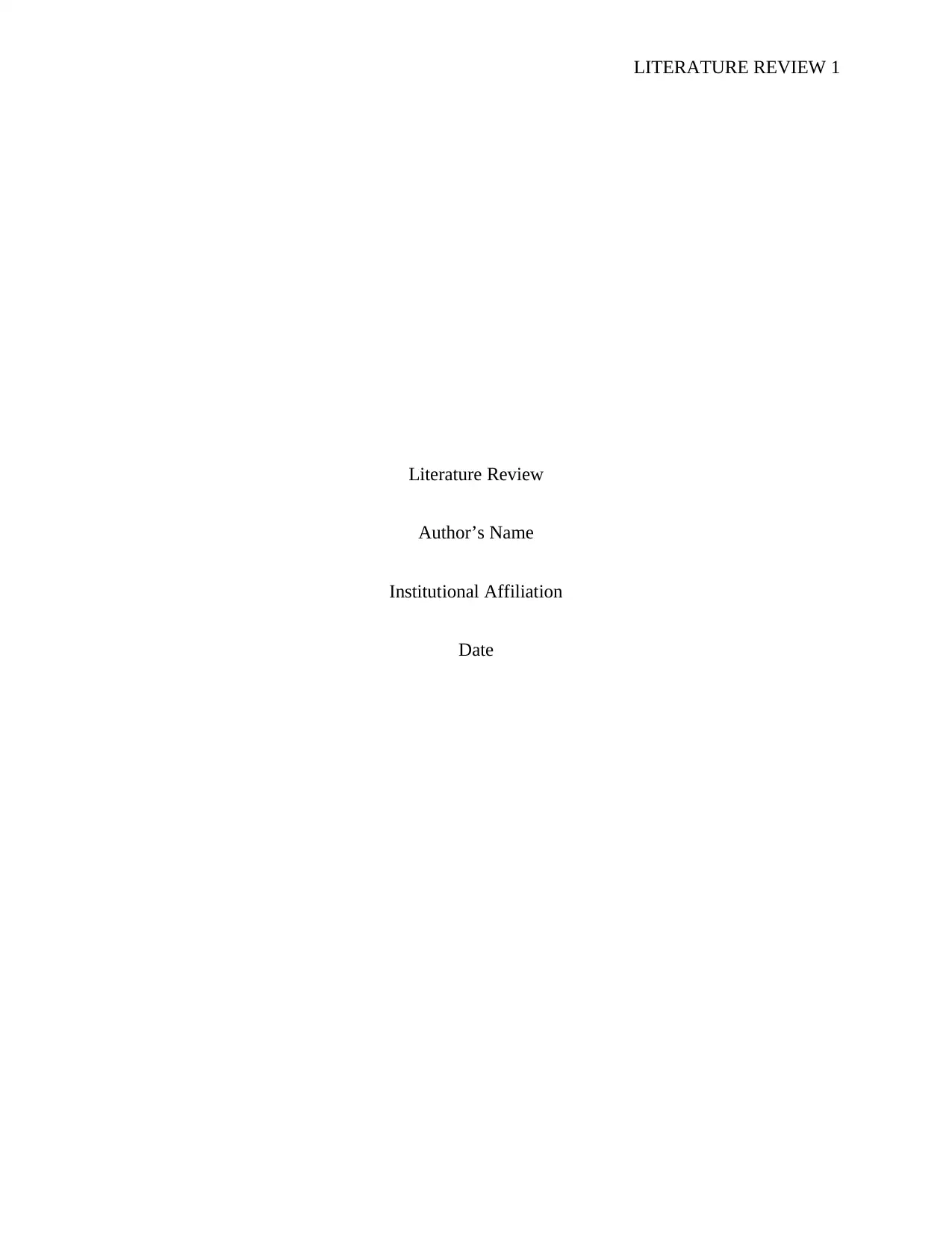
LITERATURE REVIEW 1
Literature Review
Author’s Name
Institutional Affiliation
Date
Literature Review
Author’s Name
Institutional Affiliation
Date
Paraphrase This Document
Need a fresh take? Get an instant paraphrase of this document with our AI Paraphraser
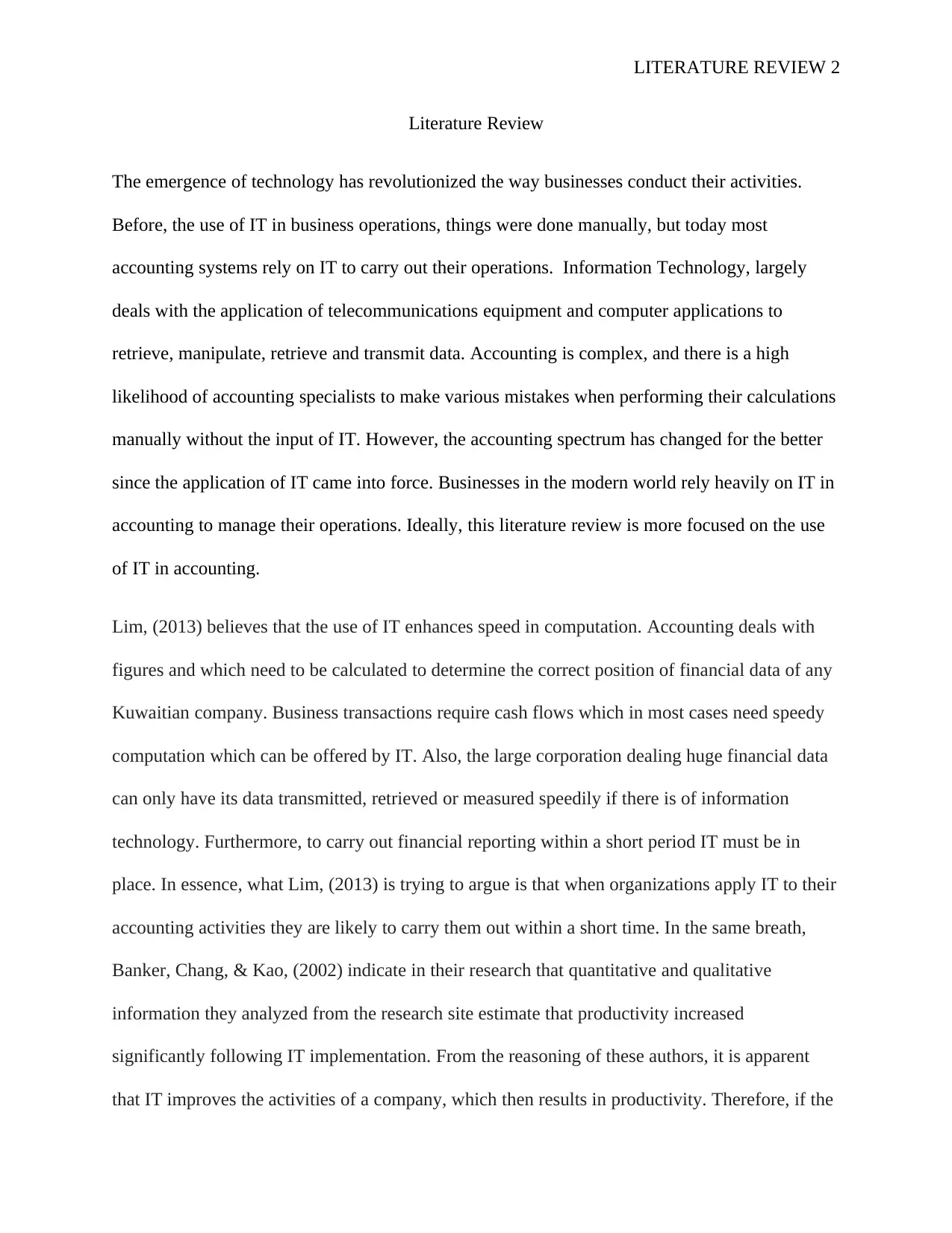
LITERATURE REVIEW 2
Literature Review
The emergence of technology has revolutionized the way businesses conduct their activities.
Before, the use of IT in business operations, things were done manually, but today most
accounting systems rely on IT to carry out their operations. Information Technology, largely
deals with the application of telecommunications equipment and computer applications to
retrieve, manipulate, retrieve and transmit data. Accounting is complex, and there is a high
likelihood of accounting specialists to make various mistakes when performing their calculations
manually without the input of IT. However, the accounting spectrum has changed for the better
since the application of IT came into force. Businesses in the modern world rely heavily on IT in
accounting to manage their operations. Ideally, this literature review is more focused on the use
of IT in accounting.
Lim, (2013) believes that the use of IT enhances speed in computation. Accounting deals with
figures and which need to be calculated to determine the correct position of financial data of any
Kuwaitian company. Business transactions require cash flows which in most cases need speedy
computation which can be offered by IT. Also, the large corporation dealing huge financial data
can only have its data transmitted, retrieved or measured speedily if there is of information
technology. Furthermore, to carry out financial reporting within a short period IT must be in
place. In essence, what Lim, (2013) is trying to argue is that when organizations apply IT to their
accounting activities they are likely to carry them out within a short time. In the same breath,
Banker, Chang, & Kao, (2002) indicate in their research that quantitative and qualitative
information they analyzed from the research site estimate that productivity increased
significantly following IT implementation. From the reasoning of these authors, it is apparent
that IT improves the activities of a company, which then results in productivity. Therefore, if the
Literature Review
The emergence of technology has revolutionized the way businesses conduct their activities.
Before, the use of IT in business operations, things were done manually, but today most
accounting systems rely on IT to carry out their operations. Information Technology, largely
deals with the application of telecommunications equipment and computer applications to
retrieve, manipulate, retrieve and transmit data. Accounting is complex, and there is a high
likelihood of accounting specialists to make various mistakes when performing their calculations
manually without the input of IT. However, the accounting spectrum has changed for the better
since the application of IT came into force. Businesses in the modern world rely heavily on IT in
accounting to manage their operations. Ideally, this literature review is more focused on the use
of IT in accounting.
Lim, (2013) believes that the use of IT enhances speed in computation. Accounting deals with
figures and which need to be calculated to determine the correct position of financial data of any
Kuwaitian company. Business transactions require cash flows which in most cases need speedy
computation which can be offered by IT. Also, the large corporation dealing huge financial data
can only have its data transmitted, retrieved or measured speedily if there is of information
technology. Furthermore, to carry out financial reporting within a short period IT must be in
place. In essence, what Lim, (2013) is trying to argue is that when organizations apply IT to their
accounting activities they are likely to carry them out within a short time. In the same breath,
Banker, Chang, & Kao, (2002) indicate in their research that quantitative and qualitative
information they analyzed from the research site estimate that productivity increased
significantly following IT implementation. From the reasoning of these authors, it is apparent
that IT improves the activities of a company, which then results in productivity. Therefore, if the
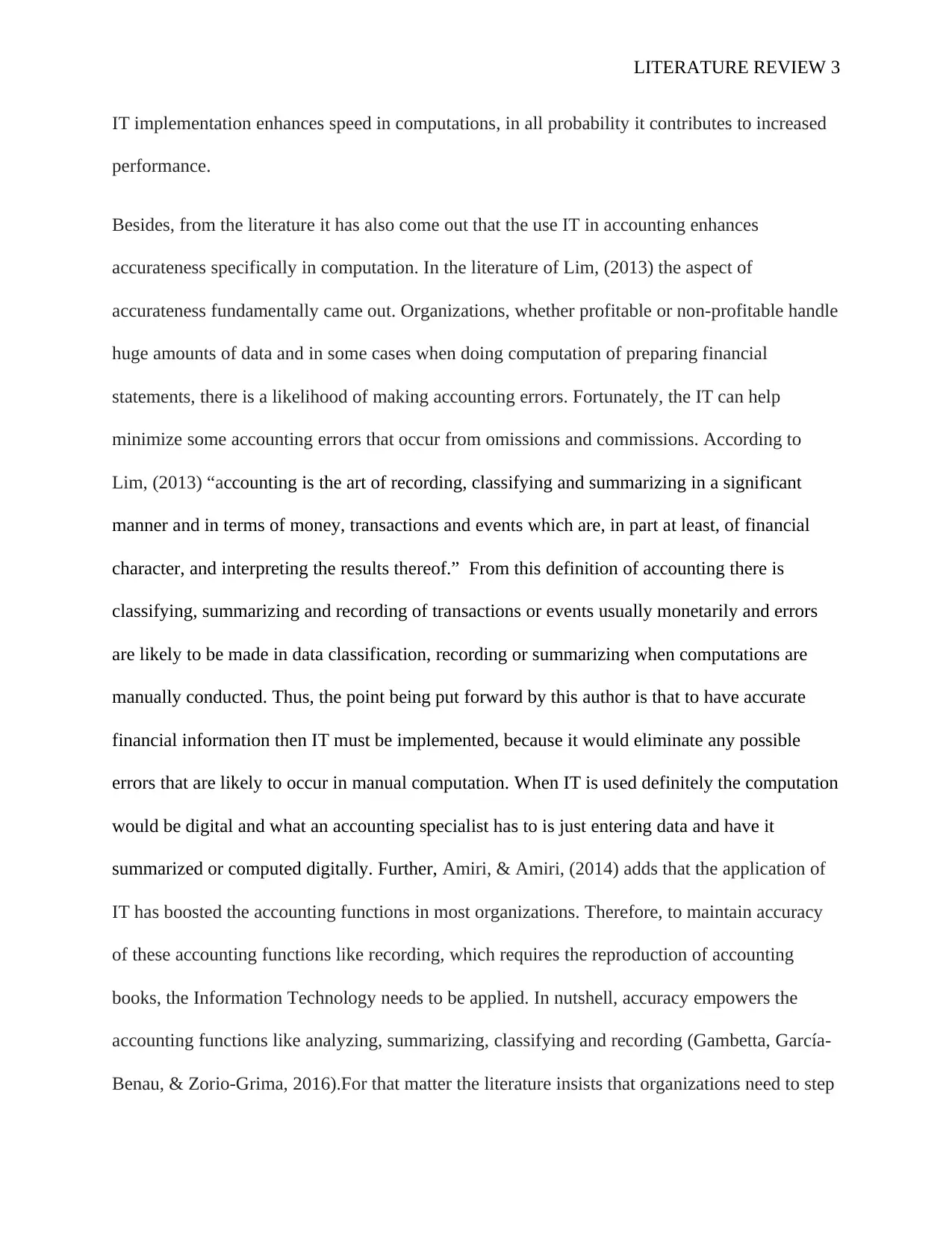
LITERATURE REVIEW 3
IT implementation enhances speed in computations, in all probability it contributes to increased
performance.
Besides, from the literature it has also come out that the use IT in accounting enhances
accurateness specifically in computation. In the literature of Lim, (2013) the aspect of
accurateness fundamentally came out. Organizations, whether profitable or non-profitable handle
huge amounts of data and in some cases when doing computation of preparing financial
statements, there is a likelihood of making accounting errors. Fortunately, the IT can help
minimize some accounting errors that occur from omissions and commissions. According to
Lim, (2013) “accounting is the art of recording, classifying and summarizing in a significant
manner and in terms of money, transactions and events which are, in part at least, of financial
character, and interpreting the results thereof.” From this definition of accounting there is
classifying, summarizing and recording of transactions or events usually monetarily and errors
are likely to be made in data classification, recording or summarizing when computations are
manually conducted. Thus, the point being put forward by this author is that to have accurate
financial information then IT must be implemented, because it would eliminate any possible
errors that are likely to occur in manual computation. When IT is used definitely the computation
would be digital and what an accounting specialist has to is just entering data and have it
summarized or computed digitally. Further, Amiri, & Amiri, (2014) adds that the application of
IT has boosted the accounting functions in most organizations. Therefore, to maintain accuracy
of these accounting functions like recording, which requires the reproduction of accounting
books, the Information Technology needs to be applied. In nutshell, accuracy empowers the
accounting functions like analyzing, summarizing, classifying and recording (Gambetta, García-
Benau, & Zorio-Grima, 2016).For that matter the literature insists that organizations need to step
IT implementation enhances speed in computations, in all probability it contributes to increased
performance.
Besides, from the literature it has also come out that the use IT in accounting enhances
accurateness specifically in computation. In the literature of Lim, (2013) the aspect of
accurateness fundamentally came out. Organizations, whether profitable or non-profitable handle
huge amounts of data and in some cases when doing computation of preparing financial
statements, there is a likelihood of making accounting errors. Fortunately, the IT can help
minimize some accounting errors that occur from omissions and commissions. According to
Lim, (2013) “accounting is the art of recording, classifying and summarizing in a significant
manner and in terms of money, transactions and events which are, in part at least, of financial
character, and interpreting the results thereof.” From this definition of accounting there is
classifying, summarizing and recording of transactions or events usually monetarily and errors
are likely to be made in data classification, recording or summarizing when computations are
manually conducted. Thus, the point being put forward by this author is that to have accurate
financial information then IT must be implemented, because it would eliminate any possible
errors that are likely to occur in manual computation. When IT is used definitely the computation
would be digital and what an accounting specialist has to is just entering data and have it
summarized or computed digitally. Further, Amiri, & Amiri, (2014) adds that the application of
IT has boosted the accounting functions in most organizations. Therefore, to maintain accuracy
of these accounting functions like recording, which requires the reproduction of accounting
books, the Information Technology needs to be applied. In nutshell, accuracy empowers the
accounting functions like analyzing, summarizing, classifying and recording (Gambetta, García-
Benau, & Zorio-Grima, 2016).For that matter the literature insists that organizations need to step
⊘ This is a preview!⊘
Do you want full access?
Subscribe today to unlock all pages.

Trusted by 1+ million students worldwide
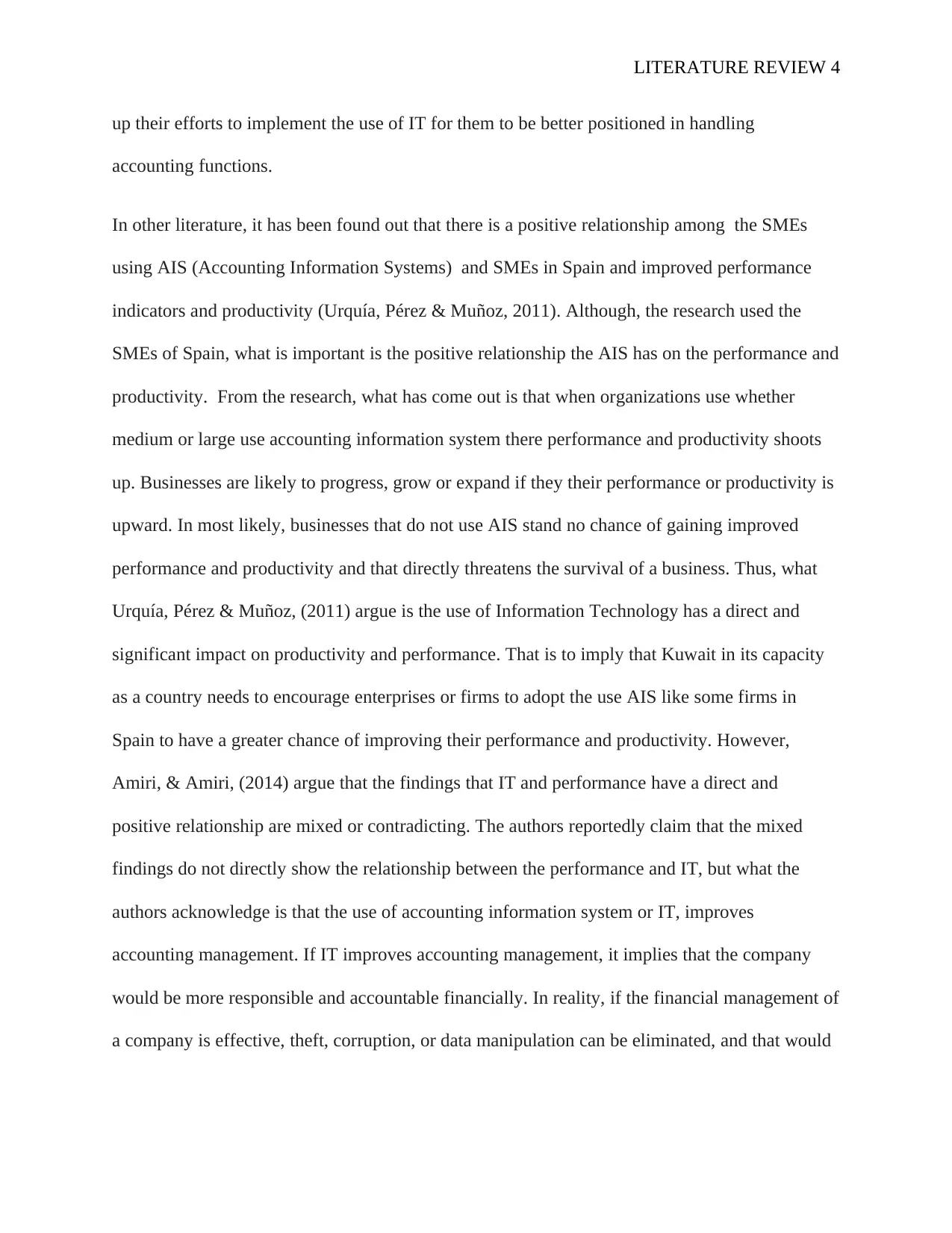
LITERATURE REVIEW 4
up their efforts to implement the use of IT for them to be better positioned in handling
accounting functions.
In other literature, it has been found out that there is a positive relationship among the SMEs
using AIS (Accounting Information Systems) and SMEs in Spain and improved performance
indicators and productivity (Urquía, Pérez & Muñoz, 2011). Although, the research used the
SMEs of Spain, what is important is the positive relationship the AIS has on the performance and
productivity. From the research, what has come out is that when organizations use whether
medium or large use accounting information system there performance and productivity shoots
up. Businesses are likely to progress, grow or expand if they their performance or productivity is
upward. In most likely, businesses that do not use AIS stand no chance of gaining improved
performance and productivity and that directly threatens the survival of a business. Thus, what
Urquía, Pérez & Muñoz, (2011) argue is the use of Information Technology has a direct and
significant impact on productivity and performance. That is to imply that Kuwait in its capacity
as a country needs to encourage enterprises or firms to adopt the use AIS like some firms in
Spain to have a greater chance of improving their performance and productivity. However,
Amiri, & Amiri, (2014) argue that the findings that IT and performance have a direct and
positive relationship are mixed or contradicting. The authors reportedly claim that the mixed
findings do not directly show the relationship between the performance and IT, but what the
authors acknowledge is that the use of accounting information system or IT, improves
accounting management. If IT improves accounting management, it implies that the company
would be more responsible and accountable financially. In reality, if the financial management of
a company is effective, theft, corruption, or data manipulation can be eliminated, and that would
up their efforts to implement the use of IT for them to be better positioned in handling
accounting functions.
In other literature, it has been found out that there is a positive relationship among the SMEs
using AIS (Accounting Information Systems) and SMEs in Spain and improved performance
indicators and productivity (Urquía, Pérez & Muñoz, 2011). Although, the research used the
SMEs of Spain, what is important is the positive relationship the AIS has on the performance and
productivity. From the research, what has come out is that when organizations use whether
medium or large use accounting information system there performance and productivity shoots
up. Businesses are likely to progress, grow or expand if they their performance or productivity is
upward. In most likely, businesses that do not use AIS stand no chance of gaining improved
performance and productivity and that directly threatens the survival of a business. Thus, what
Urquía, Pérez & Muñoz, (2011) argue is the use of Information Technology has a direct and
significant impact on productivity and performance. That is to imply that Kuwait in its capacity
as a country needs to encourage enterprises or firms to adopt the use AIS like some firms in
Spain to have a greater chance of improving their performance and productivity. However,
Amiri, & Amiri, (2014) argue that the findings that IT and performance have a direct and
positive relationship are mixed or contradicting. The authors reportedly claim that the mixed
findings do not directly show the relationship between the performance and IT, but what the
authors acknowledge is that the use of accounting information system or IT, improves
accounting management. If IT improves accounting management, it implies that the company
would be more responsible and accountable financially. In reality, if the financial management of
a company is effective, theft, corruption, or data manipulation can be eliminated, and that would
Paraphrase This Document
Need a fresh take? Get an instant paraphrase of this document with our AI Paraphraser
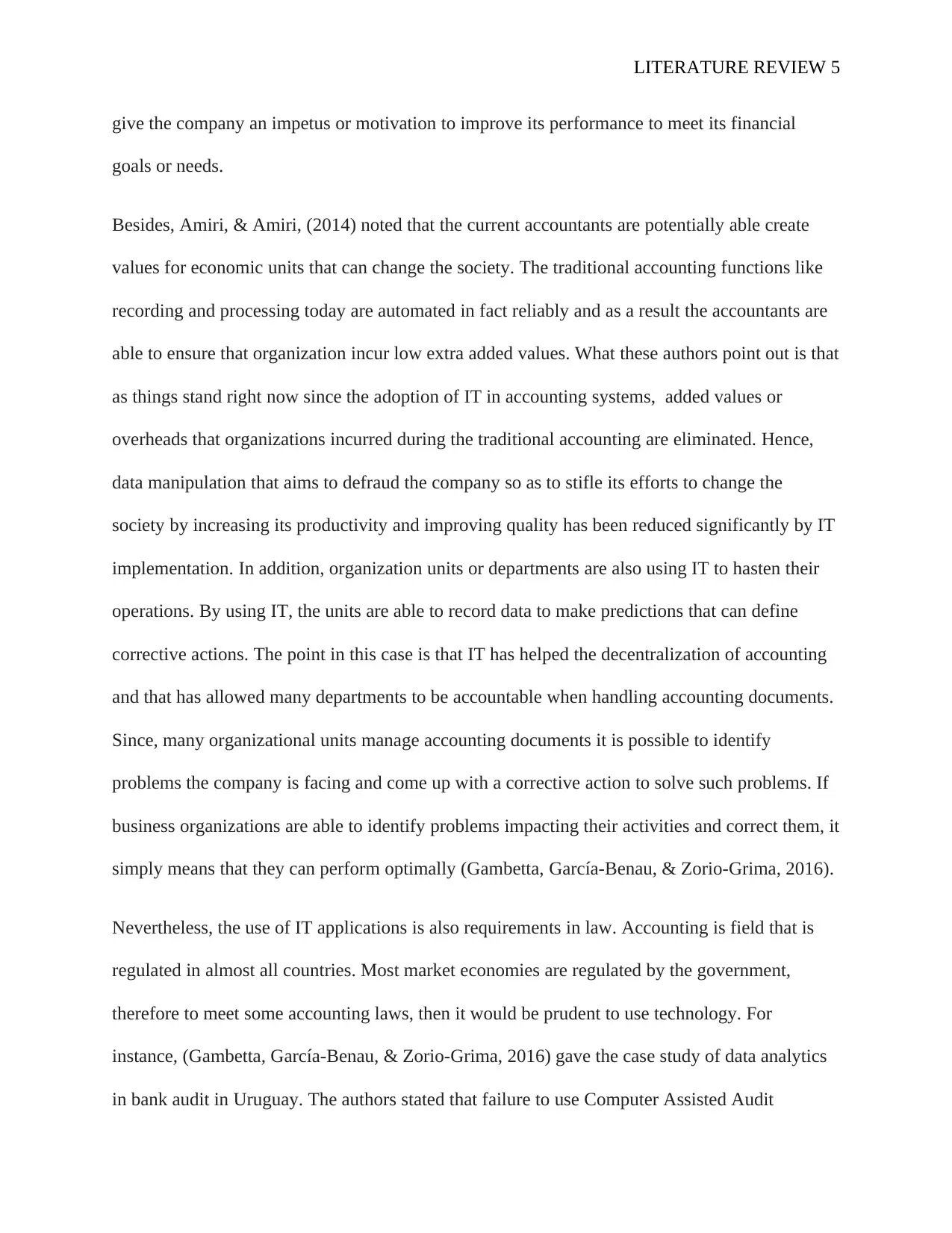
LITERATURE REVIEW 5
give the company an impetus or motivation to improve its performance to meet its financial
goals or needs.
Besides, Amiri, & Amiri, (2014) noted that the current accountants are potentially able create
values for economic units that can change the society. The traditional accounting functions like
recording and processing today are automated in fact reliably and as a result the accountants are
able to ensure that organization incur low extra added values. What these authors point out is that
as things stand right now since the adoption of IT in accounting systems, added values or
overheads that organizations incurred during the traditional accounting are eliminated. Hence,
data manipulation that aims to defraud the company so as to stifle its efforts to change the
society by increasing its productivity and improving quality has been reduced significantly by IT
implementation. In addition, organization units or departments are also using IT to hasten their
operations. By using IT, the units are able to record data to make predictions that can define
corrective actions. The point in this case is that IT has helped the decentralization of accounting
and that has allowed many departments to be accountable when handling accounting documents.
Since, many organizational units manage accounting documents it is possible to identify
problems the company is facing and come up with a corrective action to solve such problems. If
business organizations are able to identify problems impacting their activities and correct them, it
simply means that they can perform optimally (Gambetta, García-Benau, & Zorio-Grima, 2016).
Nevertheless, the use of IT applications is also requirements in law. Accounting is field that is
regulated in almost all countries. Most market economies are regulated by the government,
therefore to meet some accounting laws, then it would be prudent to use technology. For
instance, (Gambetta, García-Benau, & Zorio-Grima, 2016) gave the case study of data analytics
in bank audit in Uruguay. The authors stated that failure to use Computer Assisted Audit
give the company an impetus or motivation to improve its performance to meet its financial
goals or needs.
Besides, Amiri, & Amiri, (2014) noted that the current accountants are potentially able create
values for economic units that can change the society. The traditional accounting functions like
recording and processing today are automated in fact reliably and as a result the accountants are
able to ensure that organization incur low extra added values. What these authors point out is that
as things stand right now since the adoption of IT in accounting systems, added values or
overheads that organizations incurred during the traditional accounting are eliminated. Hence,
data manipulation that aims to defraud the company so as to stifle its efforts to change the
society by increasing its productivity and improving quality has been reduced significantly by IT
implementation. In addition, organization units or departments are also using IT to hasten their
operations. By using IT, the units are able to record data to make predictions that can define
corrective actions. The point in this case is that IT has helped the decentralization of accounting
and that has allowed many departments to be accountable when handling accounting documents.
Since, many organizational units manage accounting documents it is possible to identify
problems the company is facing and come up with a corrective action to solve such problems. If
business organizations are able to identify problems impacting their activities and correct them, it
simply means that they can perform optimally (Gambetta, García-Benau, & Zorio-Grima, 2016).
Nevertheless, the use of IT applications is also requirements in law. Accounting is field that is
regulated in almost all countries. Most market economies are regulated by the government,
therefore to meet some accounting laws, then it would be prudent to use technology. For
instance, (Gambetta, García-Benau, & Zorio-Grima, 2016) gave the case study of data analytics
in bank audit in Uruguay. The authors stated that failure to use Computer Assisted Audit
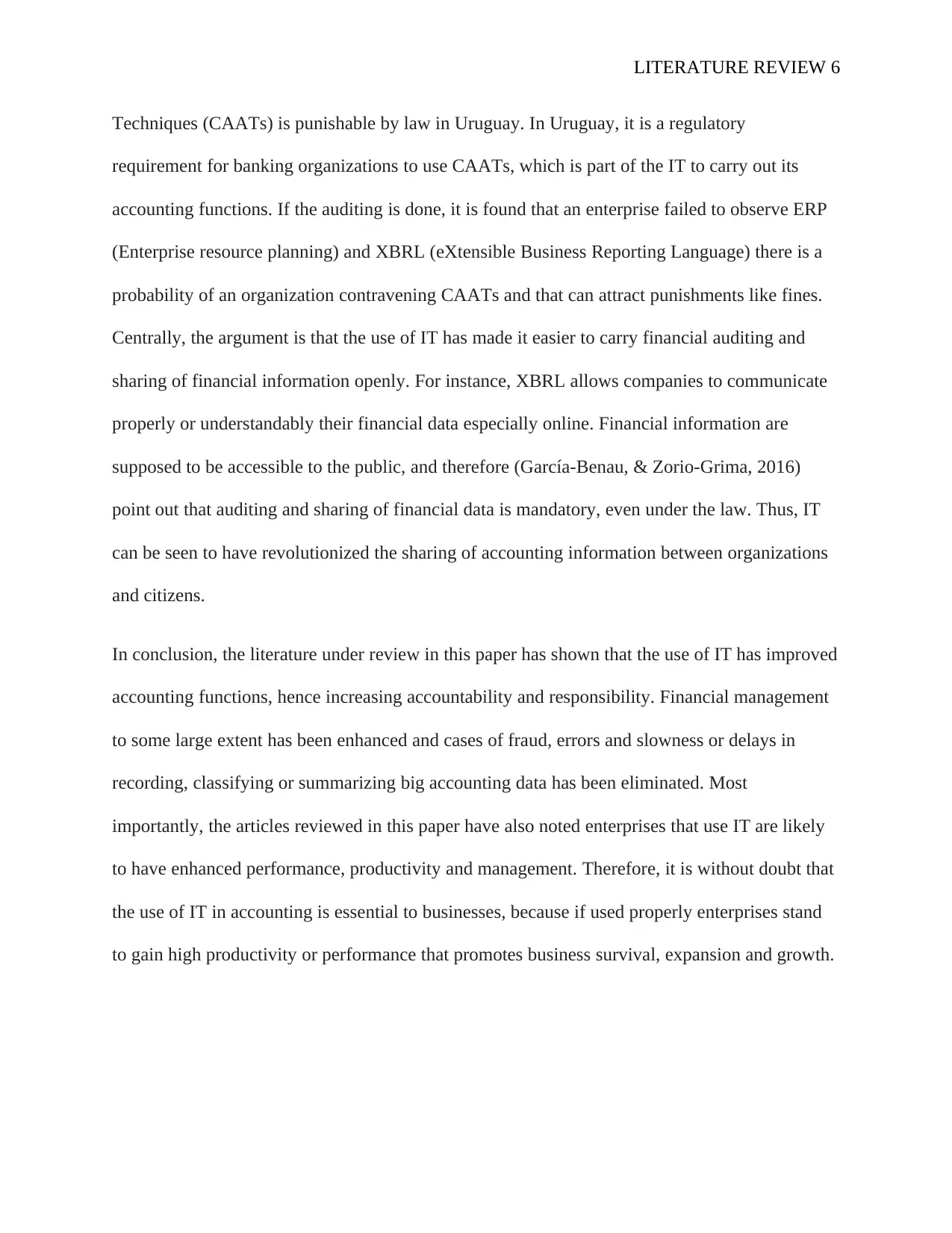
LITERATURE REVIEW 6
Techniques (CAATs) is punishable by law in Uruguay. In Uruguay, it is a regulatory
requirement for banking organizations to use CAATs, which is part of the IT to carry out its
accounting functions. If the auditing is done, it is found that an enterprise failed to observe ERP
(Enterprise resource planning) and XBRL (eXtensible Business Reporting Language) there is a
probability of an organization contravening CAATs and that can attract punishments like fines.
Centrally, the argument is that the use of IT has made it easier to carry financial auditing and
sharing of financial information openly. For instance, XBRL allows companies to communicate
properly or understandably their financial data especially online. Financial information are
supposed to be accessible to the public, and therefore (García-Benau, & Zorio-Grima, 2016)
point out that auditing and sharing of financial data is mandatory, even under the law. Thus, IT
can be seen to have revolutionized the sharing of accounting information between organizations
and citizens.
In conclusion, the literature under review in this paper has shown that the use of IT has improved
accounting functions, hence increasing accountability and responsibility. Financial management
to some large extent has been enhanced and cases of fraud, errors and slowness or delays in
recording, classifying or summarizing big accounting data has been eliminated. Most
importantly, the articles reviewed in this paper have also noted enterprises that use IT are likely
to have enhanced performance, productivity and management. Therefore, it is without doubt that
the use of IT in accounting is essential to businesses, because if used properly enterprises stand
to gain high productivity or performance that promotes business survival, expansion and growth.
Techniques (CAATs) is punishable by law in Uruguay. In Uruguay, it is a regulatory
requirement for banking organizations to use CAATs, which is part of the IT to carry out its
accounting functions. If the auditing is done, it is found that an enterprise failed to observe ERP
(Enterprise resource planning) and XBRL (eXtensible Business Reporting Language) there is a
probability of an organization contravening CAATs and that can attract punishments like fines.
Centrally, the argument is that the use of IT has made it easier to carry financial auditing and
sharing of financial information openly. For instance, XBRL allows companies to communicate
properly or understandably their financial data especially online. Financial information are
supposed to be accessible to the public, and therefore (García-Benau, & Zorio-Grima, 2016)
point out that auditing and sharing of financial data is mandatory, even under the law. Thus, IT
can be seen to have revolutionized the sharing of accounting information between organizations
and citizens.
In conclusion, the literature under review in this paper has shown that the use of IT has improved
accounting functions, hence increasing accountability and responsibility. Financial management
to some large extent has been enhanced and cases of fraud, errors and slowness or delays in
recording, classifying or summarizing big accounting data has been eliminated. Most
importantly, the articles reviewed in this paper have also noted enterprises that use IT are likely
to have enhanced performance, productivity and management. Therefore, it is without doubt that
the use of IT in accounting is essential to businesses, because if used properly enterprises stand
to gain high productivity or performance that promotes business survival, expansion and growth.
⊘ This is a preview!⊘
Do you want full access?
Subscribe today to unlock all pages.

Trusted by 1+ million students worldwide
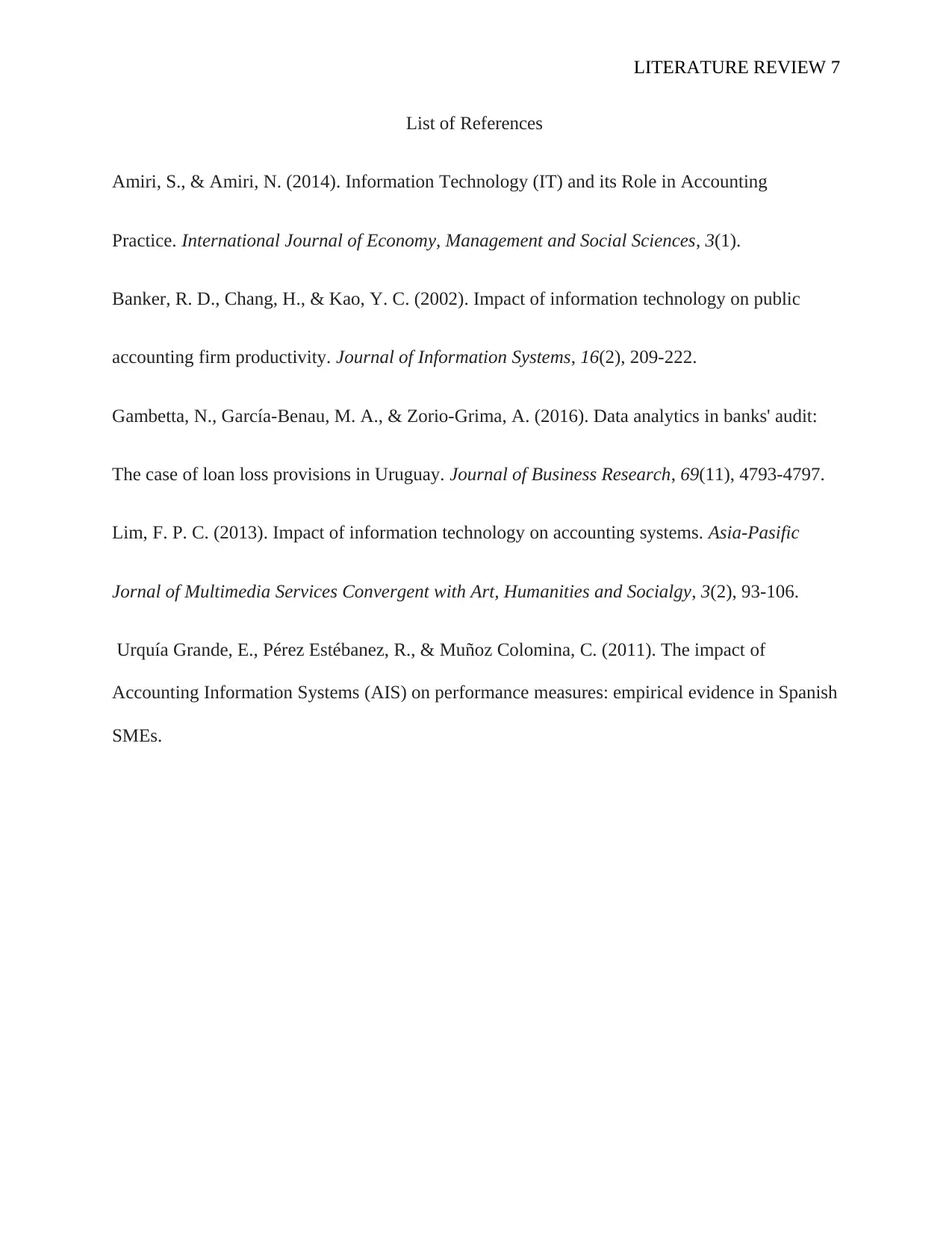
LITERATURE REVIEW 7
List of References
Amiri, S., & Amiri, N. (2014). Information Technology (IT) and its Role in Accounting
Practice. International Journal of Economy, Management and Social Sciences, 3(1).
Banker, R. D., Chang, H., & Kao, Y. C. (2002). Impact of information technology on public
accounting firm productivity. Journal of Information Systems, 16(2), 209-222.
Gambetta, N., García-Benau, M. A., & Zorio-Grima, A. (2016). Data analytics in banks' audit:
The case of loan loss provisions in Uruguay. Journal of Business Research, 69(11), 4793-4797.
Lim, F. P. C. (2013). Impact of information technology on accounting systems. Asia-Pasific
Jornal of Multimedia Services Convergent with Art, Humanities and Socialgy, 3(2), 93-106.
Urquía Grande, E., Pérez Estébanez, R., & Muñoz Colomina, C. (2011). The impact of
Accounting Information Systems (AIS) on performance measures: empirical evidence in Spanish
SMEs.
List of References
Amiri, S., & Amiri, N. (2014). Information Technology (IT) and its Role in Accounting
Practice. International Journal of Economy, Management and Social Sciences, 3(1).
Banker, R. D., Chang, H., & Kao, Y. C. (2002). Impact of information technology on public
accounting firm productivity. Journal of Information Systems, 16(2), 209-222.
Gambetta, N., García-Benau, M. A., & Zorio-Grima, A. (2016). Data analytics in banks' audit:
The case of loan loss provisions in Uruguay. Journal of Business Research, 69(11), 4793-4797.
Lim, F. P. C. (2013). Impact of information technology on accounting systems. Asia-Pasific
Jornal of Multimedia Services Convergent with Art, Humanities and Socialgy, 3(2), 93-106.
Urquía Grande, E., Pérez Estébanez, R., & Muñoz Colomina, C. (2011). The impact of
Accounting Information Systems (AIS) on performance measures: empirical evidence in Spanish
SMEs.
1 out of 7
Related Documents
Your All-in-One AI-Powered Toolkit for Academic Success.
+13062052269
info@desklib.com
Available 24*7 on WhatsApp / Email
![[object Object]](/_next/static/media/star-bottom.7253800d.svg)
Unlock your academic potential
Copyright © 2020–2025 A2Z Services. All Rights Reserved. Developed and managed by ZUCOL.





